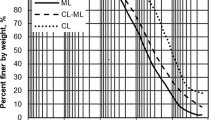Abstract
In the current article a numerical parametric study has been performed to investigate the distribution of tension in the geosynthetic layers and the distribution of shear strains in the slope backfill. Literature suggests varied opinions regarding the location of maximum tension along slope elevation. Few researchers have assumed that peak tension occurs at the toe whereas several others assumed it to occur at the mid-height of slope. To address this issue, numerical simulations of geosynthetic reinforced soil slopes are carried out using a finite element program. Slope inclination, properties of backfill soil, properties of geosynthetics and surcharge pressure on slope crest were varied in these simulations to understand the influence of these parameters on the location and magnitude of peak tension mobilized along the reinforcement layers. This study reveals that the location and magnitude of peak tension in reinforcement for slopes depends on several parameters, most importantly on the slope inclination, spacing of reinforcing layers and surcharge pressure on the slope. In all the cases, location of peak tension was found to be coinciding with the potential failure surface due to high shear strain concentration along failure surface.














Similar content being viewed by others
References
Cheng YM, Lensivaara T, Wei WB (2007) Two-dimensional slope stability analysis by limit equilibrium and strength reduction methods. Comput Geotech 34(3):137–150
Diederichs SM, Lato M, Hammah R, Quinn P (2007) Shear strength reduction approach for slope stability analyses. In: Proceedings of the 1st Canada-US Rock mechanical symposium, Vancouver, pp 1–8
Griffiths DV, Lane PA (1999) Slope stability analysis by finite element. Geotechnique 49(3):387–403
Gourc JP, Gotteland Ph., Haza E, Perrier H, Baraize E (1995) Geotextile reinforced structures as bridge abutments: fullscale experimentation. In: Proceedings of the 5th international conference on geosynthetics, Nashville, USA, pp 79–92
Han J, Leshchinsky D, Shao Y (2002) Influence of tensile stiffness of geosynthetic reinforcements on performance of reinforced slopes, Proceedings in Geosynthetics—7 ICG—Delmas, pp 197–200
Kanungo DP, Pain A, Sharma S (2013) Finite element modeling approach to assess the stability of debris and rock slopes: a case study from the Indian Himalayas. J Int Soc Prev Mitig Nat Hazards 69(1):1–24
Latha GM, Somwanshi A (2009) Bearing capacity of square footings on geosynthetic reinforced sand. Geotext Geomembr 27(4):281–294
Matsui T, Sam KC (1992) Finite element slope stability analysis by shear strength reduction technique. Soils Found 32(1):59–70
PHASE2 manual. http://www.rocscience.com/products/Phase2.asp
Rowe KR, Li AL (1999) Reinforced embankments over soft foundations under undrained and partially drained conditions. Geotext Geomembr 17(3):129–146
Shiwakoti DR, Pradhan TBS, Leshchinsky D (1999) Performance of geosynthetic-reinforced soil structures at limit equilibrium state. Geosynth Int 5(6):555–587
Sommers AN, Viswanadham BVS (2009) Centrifuge model tests on the behavior of strip footing on geotextile-reinforced slopes. Geotext Geomembr 27(6):497–505
Viswanadham BVS, Mahajan RR (2007) Centrifuge model tests on geotextile-reinforced slopes. Geosynth Int 14(6):365–379
Yang KH, Zornberg JG, Liu CN, Lin HD (2012) Stress distribution and development within geosynthetic-reinforced soil slopes. Geosynth Int 19(1):62–78
Zienkiewicz OC, Taylor RL (1989) The finite element method, vol 1, 4th edn. McGraw Hill, London
Zornberg JG, Arriaga F (2003) Strain distribution within geosynthetic-reinforced slopes. J Geotech Geoenviron Eng 131(2):141–150
Acknowledgments
The authors would like to thank Mr. Saurabh Singh Patel, M.E. student in IISc Bangalore for his valuable advices and constant support.
Author information
Authors and Affiliations
Corresponding author
Rights and permissions
About this article
Cite this article
Tiwari, G., Samadhiya, N.K. Factors Influencing the Distribution of Peak Tension in Geosynthetic Reinforced Soil Slopes. Indian Geotech J 46, 34–44 (2016). https://doi.org/10.1007/s40098-015-0147-5
Received:
Accepted:
Published:
Issue Date:
DOI: https://doi.org/10.1007/s40098-015-0147-5




